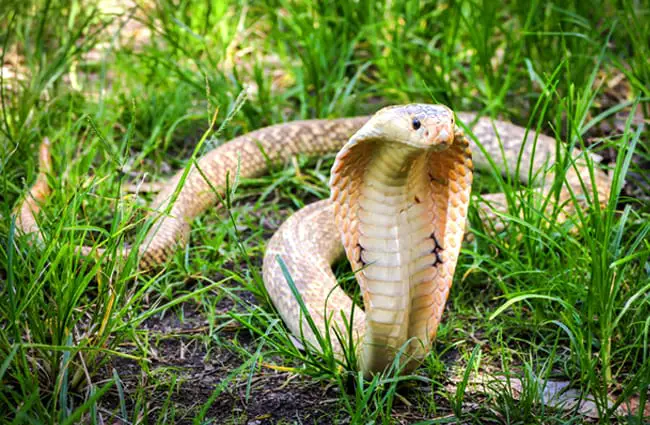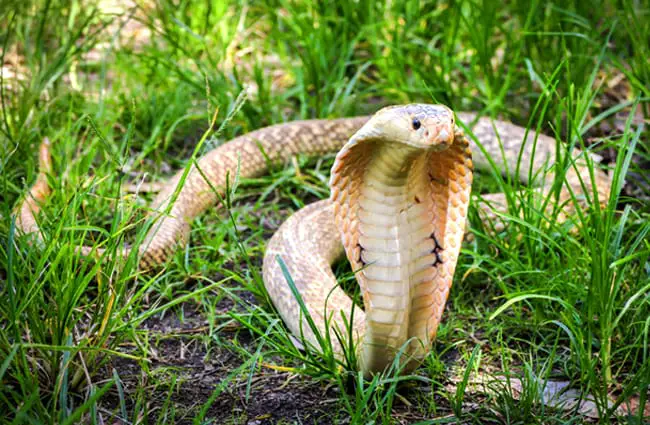The King Cobra is one of the most fascinating creatures on the planet. With its majestic appearance and deadly venom, it has captured the imagination of people around the world. But where does this enigmatic snake call home?
The King Cobra’s habitat is as diverse as it is vast. From the dense jungles of Southeast Asia to the arid deserts of India, these snakes can be found in a variety of environments. Understanding the King Cobra’s habitat is crucial to both its survival and ours, as we continue to encroach upon its territory. Let’s take a closer look at where the King Cobra lives and what makes its habitat so unique.
The King Cobra is found in a range of habitats across Southeast Asia, including dense forests, mangroves, and agricultural areas. They prefer areas with access to water sources and an abundance of prey, such as rodents and other small mammals.

What is the King Cobra’s Habitat?
King cobras, scientifically known as Ophiophagus hannah, are one of the most venomous snakes in the world. They are also the longest venomous snake, growing up to 18 feet in length. They are native to Southeast Asia and are found in countries like India, Bangladesh, Myanmar, and Thailand. In this article, we will explore the habitat of the king cobra in detail.
Geographical Range
The habitat of the king cobra spans across a vast geographical area. They are found in a range of habitats, including forests, grasslands, and swamps. They are usually found in areas with dense vegetation, where they can easily hide and hunt for prey. King cobras are mainly found in Southeast Asia, including India, Bangladesh, Myanmar, Thailand, Laos, Cambodia, Vietnam, Malaysia, and Indonesia.
King cobras are adaptable to different environments, and they can live in different types of forests, including rainforests, deciduous forests, and bamboo forests. They are also found in grasslands and swamps, where they can find their prey easily. They are also known to live near water bodies, such as rivers and streams.
Climate
King cobras are found in tropical and subtropical climates. They thrive in hot and humid environments, where the temperature can range from 20°C to 35°C. They prefer areas with high humidity, such as rainforests and swamps. King cobras are also found in areas with high rainfall, which allows for the growth of dense vegetation that provides them with shelter and food.
Vegetation
King cobras are found in areas with dense vegetation, such as forests, grasslands, and swamps. They prefer areas with tall trees and thick undergrowth, which provides them with hiding places and hunting grounds. They are also found in areas with bamboo forests, where they can easily hide and hunt for prey.
King cobras are known to live near water bodies, such as rivers and streams, where they can find their prey easily. They are also found in areas with high rainfall, which supports the growth of dense vegetation.
Prey
King cobras are apex predators and feed on a variety of prey, including rodents, lizards, birds, and other snakes. They are known to feed on other venomous snakes, such as cobras and kraits. They are also known to feed on non-venomous snakes, such as rat snakes and pythons.
King cobras are opportunistic hunters and can go without food for several months. They hunt primarily during the night or early morning and use their keen sense of smell to locate their prey. They are also known to use their sight and sound to locate their prey.
Behavior
King cobras are solitary animals and are usually found alone. They are known to be aggressive when threatened and will attack if provoked. They are also known to be territorial and will defend their territory against other snakes.
King cobras are known for their unique behavior of building nests for their eggs. The female king cobra builds a nest using leaves, sticks, and other debris, and guards it until the eggs hatch. King cobras are also known to be excellent swimmers and can swim for long distances.
Threats
King cobras are threatened by habitat loss and human encroachment. They are also hunted for their skin and meat, which is used in traditional medicine in some countries. King cobras are also killed by humans for fear of their venomous bite.
Conservation efforts are being made to protect the habitat of the king cobra. Protected areas have been established in some countries, where the king cobra is found. Efforts are also being made to reduce human-wildlife conflict and to raise awareness about the importance of conserving the king cobra.
Benefits
King cobras play an important role in the ecosystem as apex predators. They help to control the population of rodents and other prey species, which can cause damage to crops and other vegetation.
King cobras are also important in traditional medicine in some countries. Their venom is used to treat a variety of ailments, including arthritis, asthma, and cancer. However, the use of king cobra venom in traditional medicine is controversial, and efforts are being made to find alternatives.
King Cobra vs Other Snakes
King cobras are larger and more venomous than most other snakes. They are also known for their unique behavior, such as building nests for their eggs. They are apex predators and feed on a variety of prey, including other venomous snakes.
King cobras are also more aggressive than most other snakes and will attack if provoked. They are known for their ability to stand up and spread their hood, which is a warning sign to potential predators.
Conclusion
King cobras are fascinating creatures that are found in a range of habitats across Southeast Asia. They are apex predators and feed on a variety of prey, including other venomous snakes. They are threatened by habitat loss and human encroachment, and efforts are being made to protect their habitat.
Conservation efforts are important to ensure the survival of the king cobra and to maintain the balance of the ecosystem. The king cobra plays an important role in the ecosystem as an apex predator, and its conservation is vital to the health of the ecosystem.
Frequently Asked Questions
Here are some common questions about the habitat of King Cobras:
What type of habitat do King Cobras prefer?
King Cobras are typically found in forested areas, often near bodies of water such as streams or ponds. They can also be found in agricultural land or near human settlements. King Cobras are native to Southeast Asia, but can also be found in parts of India and China.
Within their preferred habitat, King Cobras tend to seek out areas with dense vegetation, such as bamboo groves or thickets. They also prefer areas with plenty of prey, such as rodents and other small animals.
What kind of shelter do King Cobras require?
King Cobras are known to use a variety of shelters within their habitat. These can include hollow trees, rock crevices, and abandoned buildings. The cobras may also dig burrows or use existing holes in the ground.
When selecting a shelter, King Cobras tend to prefer areas that are hidden or difficult to access. This helps protect them from predators and other threats. They may also choose a shelter that provides easy access to food and water sources.
How do King Cobras adapt to changes in their habitat?
King Cobras are known to be adaptable to changes in their habitat. For example, they may move to new areas if their current habitat becomes unsuitable due to human activity or natural disasters.
In some cases, King Cobras may also change their behavior in response to changes in their environment. For example, they may alter their diet in order to better survive in a new habitat.
What threats do King Cobras face in their natural habitat?
King Cobras face a number of threats in their natural habitat. One of the biggest threats is habitat loss due to deforestation and other human activities. They may also be killed by humans who view them as a danger to livestock or pets.
King Cobras are also at risk of being hunted for their skin and other body parts, which are used in traditional medicine. Climate change may also pose a threat to King Cobras by altering their habitat and food sources.
What conservation efforts are being made to protect King Cobras and their habitat?
Conservation efforts for King Cobras and their habitat include protecting forested areas from deforestation and illegal logging. There are also efforts to reduce the hunting and poaching of King Cobras for their skin and other body parts.
Additionally, education and outreach programs are being implemented to raise awareness about the importance of King Cobras and their role in the ecosystem. These efforts aim to promote sustainable practices that benefit both the cobras and the local communities that share their habitat.
The Deadly King Cobra!
In conclusion, the King Cobra is a fascinating and dangerous snake that is found in a variety of habitats throughout Southeast Asia. While they are commonly associated with dense jungles and forests, they have also been found in rice paddies, grasslands, and even human settlements.
Despite their fearsome reputation, King Cobras play an important role in their ecosystems, keeping populations of rodents and other small animals in check. It is important that we continue to study and protect these magnificent creatures and their habitats so that they can continue to thrive in the wild for generations to come.
Overall, the King Cobra’s habitat is varied and complex, reflecting the diverse environments in which it can be found. Whether living in the jungle or in human settlements, these snakes are a vital part of their ecosystems and are truly awe-inspiring to behold.


